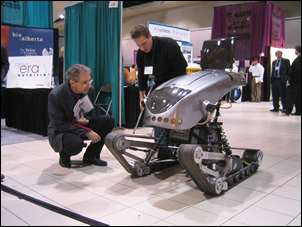|

______________________
BY RYAN B. LAWRENCE
University of Alberta
Student Contributor
______________________ |
 |
Excitement builds as onlookers anticipate the start of the
competition. Designers stand at the sidelines, anxious and
hopeful. Finally the whistle is blown and the vehicle zips
off.
But wait! Where’s the driver? Where’s the remote
control?
Ah yes, that’s what makes this competition different
from the others. The vehicle is autonomous – it needs
neither driver nor remote control. It is self-governing.
In other words, this vehicle drives itself.
That makes it the centrepiece of what the U of A calls the
Autonomous Robotic Vehicle Project. ARVP began in 1996, so
it’s one of the more recently established student projects
at the university. Its main goal every year is to complete
a robot for the International Ground Robotics Competition,
held in the U.S.
The competition itself is fairly new as well, founded in
1992 by a number of organizations, among them the Association
for Unmanned Vehicle Systems International, Oakland University,
the Society of Automotive Engineers, and the U.S. Army Tank-Automotive
Armament Command.
 |
| The next generation of the autonomous
robotic vehicle is being built upon the Kodiak platform. |
Plenty of Interest
The world looks on because the applications of these robots
are of wide interest. And with sponsors such as the United
States Department of Defense, General Motors and CSI Wireless,
to name just a few, you can see why such a competition
would raise a few eyebrows.
This summer, about 25 universities from around the world,
including the U.S., Canada and Japan, will meet at Oakland
University in Rochester, Mich., to compete in the ground
robotics competition.
There are three main events. The Autonomous Challenge has
the vehicles navigate themselves around an outdoor obstacle
course within an allotted time. The Design Challenge involves
a written report on the vehicle and a complete presentation
in front of judges.
And finally, the Navigation Challenge has the vehicles drive
themselves to several targets, using only their global positioning
system and coordinates for checkpoints. If this weren’t
enough, the vehicles must also contend with obstacles set
up on the course.
To complete the daunting tasks the competition presents,
the ARVP team is divided into six sub-teams, as well as an
overall team executive.
The sponsorship, logistics, administration and management
team facilitates the actions of the rest of the sub-teams.
It orders parts, balances the books, recruits sponsors, and
organizes events and activities for the ARVP to attend.
The Outreach team generates interest in the project, and
educates students and the public about robotics, programming,
logic and mechanics in a hands-on fashion. This team has
travelled to schools, shows, conventions and science fairs.
The mechanical, electrical, software, and feature and application
teams take care of the technical aspects of the project.
The first three of these are self-explanatory, but the feature
and application team probably isn’t.
An Eye for Commercial Applications
The FAT team, as it’s known, brings an entrepreneurial
touch to the project. Members look to design features and
applications for the robotic vehicle that may eventually
be used as a consumer product.
Indeed, about two years ago the FAT team designed the Mobile
Robotic Analysis System, which was attached to the robotic
vehicle to take soil samples from areas found to be hazardous
for human exposure. This design won them the team an opportunity
to compete in a Canada-wide competition in 2002.
The ARVP has enjoyed much praise and recognition. It won
the International Ground Robotics Competition navigation
challenge in 2001 with its Bear Cub robot. It went on to
place second in the 2002 IGVC design competition with Kodiak.
Toys Were Them
And then there was 2003. That year, a shipping error had
the ARVP team showing up with only half a vehicle.
Team members did not throw in the towel, however. Instead,
they high-tailed it to a nearby Toys-R-Us, bought a children’s
electric ride-on vehicle for $10, and with extra pieces from
Home Depot and Sears, plus loads of Velcro, built what they
lovingly called the KodiHack.
The electronics, computer equipment and fibreglass shell
that the ARVP team did have were combined with the local
materials to fashion a robot that met all the specifications
of the competition – in time, by the way, to win fourth
place in design. Judges and peers were thoroughly impressed
by the resourcefulness and sharp wittedness of the team.
Who knows what fate will toss the team’s way in 2004.
But David Kastelan, ARVP leader, says things look good for
the next generation of autonomous robotic vehicle.
“
The current platform, Kodiak, is undergoing a number of revisions
that will render it a turnkey vehicle,” he says. “Many
sensors are being added to contribute to the advancements
in the robot’s artificial intelligence and will make
the ARVP a serious contender for the Grand Award in June.”
See the vehicle up close and personal on Saturday, Jan. 10,
at the Odyssium, as well as at the Edmonton International
Auto Show from Feb. 26-29. The ARVP also welcomes requests
from schools, community groups, and companies for presentations
on robotics.

E-mail
arvp@ee.ualberta.ca
Or visit
www.ee.ualberta.ca/~arvp
and
www.igvc.org

|




